The Moment the Packers Knew Jordan Love Was Ready to Take Over for Aaron Rodgers
More from Albert Breer: Takeaways: Matthew Stafford Is Healthier Than He’s Been in Years | Chargers Are Trying to Emulate This NBA Dynasty’s Culture
At the end of every week in the fall, Matt LaFleur has his quarterbacks—not just the starter, but all of them—go through the offensive plays in the game plan and rank them. It’s an exercise done chiefly to make sure he, as a play-caller, is aware of what his quarterbacks are comfortable with, and what they’re not. And so came a big moment for Jordan Love.
Love was the backup in the Packers’ Sunday night showdown in Philly last November after Aaron Rodgers injured his ribs on the team’s first possession of the fourth quarter. Green Bay was down 37–23 and, on his fourth snap, Love found rookie Christian Watson on a slant over the middle for a 63-yard catch-and-run score, cutting the lead to 37–30. Philly responded with a field goal to move the score back to 40–30.
And while the Eagles were driving the field, it stuck with LaFleur that he had a call that’d perfectly exploit a loose quarters coverage Philly had been running. The problem? Where it ranked on Love’s list of calls was in, as LaFleur recalls it, Do Not Call This If I Go In territory.
“But I kept seeing the look for it,” LaFleur says.
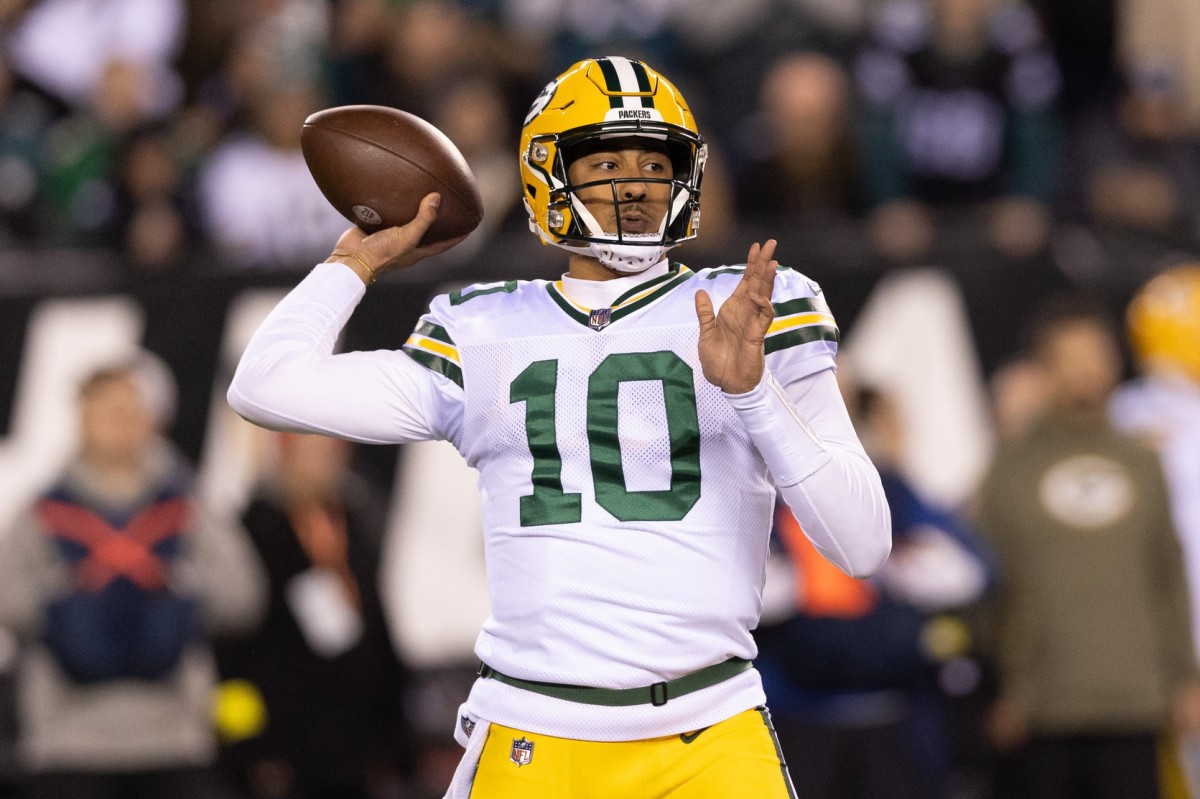
So after Love started the next series with a 15-yard throw to Watson and a first-down incompletion, the coach spit into the headset, Hey, do you trust me? Can I call this?
Yeah, Love responded, Let’s let it eat.
The high-low concept worked as LaFleur thought it would. An underneath receiver ran a pivot route (when a receiver breaks sharply over the middle, stops, and cuts back toward the sideline), which put the defender in conflict as Allen Lazard wrapped behind him, and Love delivered a strike to Lazard for a 17-yard gain. From there the Packers kicked a field goal, an onside kick to get the ball back failed and Green Bay lost by a touchdown, 40–33.
But the game, and the moment, would reverberate at Lambeau Field well past Thanksgiving. In fact, in January and February, when Green Bay was mapping out its offseason, and considering the chances that Aaron Rodgers wouldn’t be back, it’d be something coaches and execs could point back to—and feel convinced on, as concerns over whether Love would make it harbored after the quarterback’s second year slowly evaporated in Year 3.
“You can have the best play design, and if the guy’s not confident, whether he’s not comfortable with it or whatever, it really doesn’t matter,” LaFleur says, relaxing under a canopy after a sticky late July practice. “You always want to push your players, and you want to make them uncomfortable. That time is typically in practice. It’s hard to push that on somebody in a game. I was proud he trusted us enough to get him to the right look.
“He went out there and he ultimately executed it.”
And, quietly, he was winning over the staff, too, erasing skepticism and starting to shift the plates under the Packers’ quarterback room for the first time in 15 years.
I did 2,000 miles of driving, and as you read this, I’m about to visit my 15th team. We’re rolling now. And here’s what we have in the first MMQB of August …
• Why this is a different camp for Matthew Stafford.
• How the Golden State Warriors are impacting the NFL.
• Coming later in the week, a fun conversation with Ja’Marr Chase and Tee Higgins on where the Bengals are, and where they’re going. Plus, more on the direction of the Bears.
But we’re starting with the Rodgers-less Packers, and where Love might take them next.
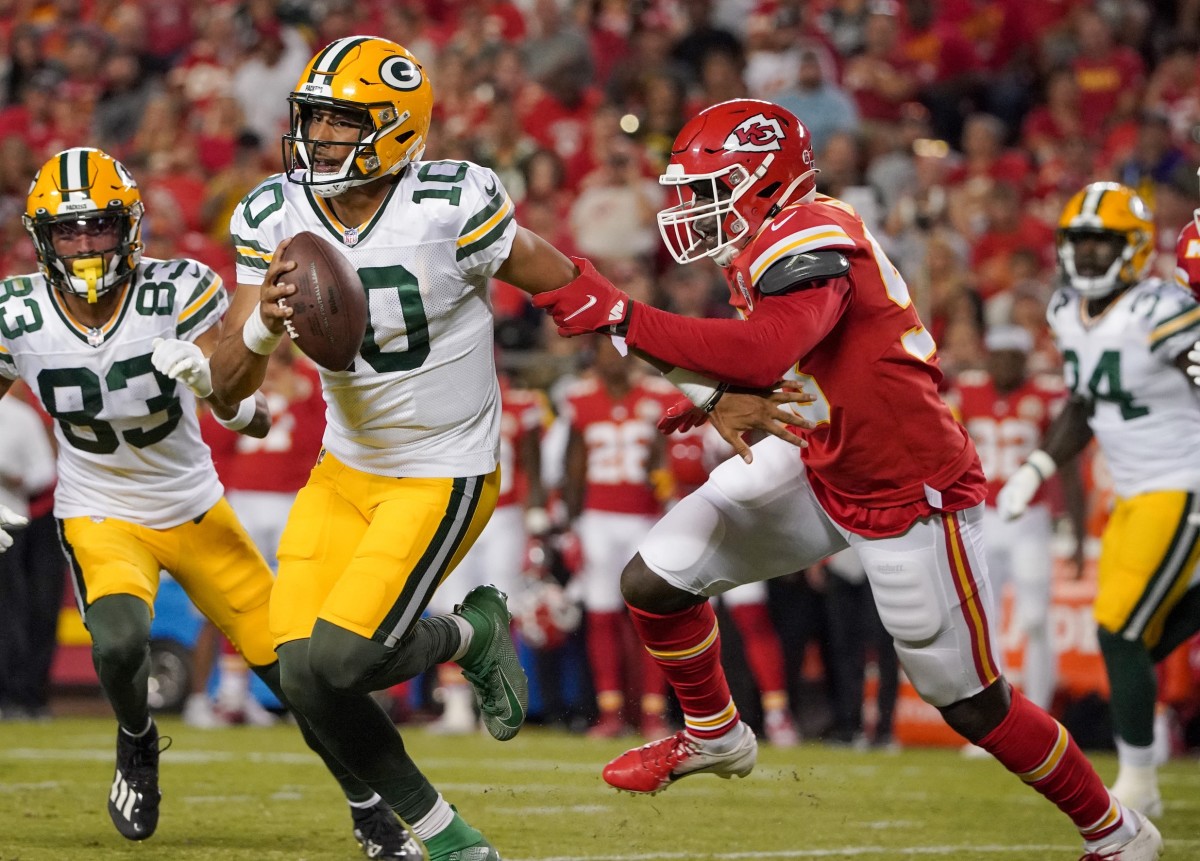
There were lots of moving parts to the Rodgers trade. There was the decision to let go of a raft of veterans to whom Rodgers had been tied. Another was the sense that Rodgers was feeling like his time in Green Bay had run its course. Another was the lack of communication between the sides in January, when the Packers wanted to articulate their plan for the roster to their quarterback, knowing he probably wouldn’t like it.
But there’s also a specific reason the Packers acted far less desperate to hang on to Rodgers than they did in 2021 or ’22, and it wasn’t because they thought Rodgers couldn’t play anymore.
It’s that, finally, they felt like Love really could play.
And that Philly game was, to be sure, a turning point. It was also his overall handling of the situation. A little more than a year earlier, Love had been thrown into the fire against the Chiefs on the road—after Rodgers tested positive for COVID-19—and while the coaches thought he showed his toughness that night, there wasn’t all that much from Love’s first start for them to wrap their arms around from a football standpoint.
Against the Eagles, the NFC champs-to-be, and their fierce pass rush, it wasn’t just that he didn’t blink. It was that he actually played well.
“The thing that was so impressive to me was, and granted it was a very limited sample size, but I just love his composure in the Philly game,” LaFleur says. “You’re talking [about] a prime-time game, just thrust in there, and he f---ing performed. That’s where we’re like, Wow this kid has come a long way. The little things, you notice from him.”
There is also a way of paralleling that night with the Kansas City game of November 2021. A couple of years later, LaFleur still feels the sting of that one. It was Wednesday of that week when he found out Love would start, and he’d wind up regretting not anticipating what Chiefs defensive coordinator Steve Spagnuolo—who’s aggressive to begin with—would throw at the young QB.
“They zero blitzed the hell out of us,” LaFleur says. “Would they have done that to Aaron? Probably not. It was just a different set of circumstances, because we didn’t know until Wednesday. What I should have done in hindsight is start over with the game plan, not to throw everything out, but just have better answers for him specifically so it took a little off his plate. I was worried about it going into the game, and my biggest fears came true.
“I’m still kicking myself about that.”
“That experience in Kansas City was an eye-opening experience,” Love says. “Like, O.K., this is what it’s like now; it’s not preseason, you get in a real game, where these defensive coordinators have been game-planning for exactly the looks you might mess up on, and I don’t have the right answer for. And then, obviously, if you don’t pick it up in the game, they’re going to keep sending the same stuff.”
Because he never found a way to manage the chaos, Love threw for just 190 yards and a 69.5 passer rating that afternoon at Arrowhead, and the Packers were held to seven points. Conversely, amid even more tumult, just a year later—in Philly, at night, coming in down two touchdowns in the fourth quarter—Love was just about exactly what the Packers needed in a pinch. He threw for 113 yards and a 146.8 rating, and put points on the scoreboard on both of his possessions after taking his first snap with 11:11 to go.
And, again, there was that throw he made, one he recalled instantly when I relayed the story LaFleur had offered up.
“It goes both ways,” Love says. “I’m definitely more comfortable with running pretty much every play we have in our offense. It just comes down to which plays I really like and which plays I’m slower at. I’m whatever with that one, but at the same time, it comes down to Matt having that trust, that he’ll call the play that maybe I might not be so comfortable with, but still be able to run it and execute it and believe that I can go out there and handle that.
“At the end of the day, I’m a guy that, if a coach feels like something’s going to work, he likes the look, I’m like, Hey, let’s let it ride. Let’s run it. Try it out. I got trust—trust goes both ways. I believe in Matt and I believe he knows very well what he’s doing out there, what plays work versus what looks, and he’s going to get us the right stuff.”
But, as the juxtaposition of the Chiefs game shows, that trust wasn’t established overnight.
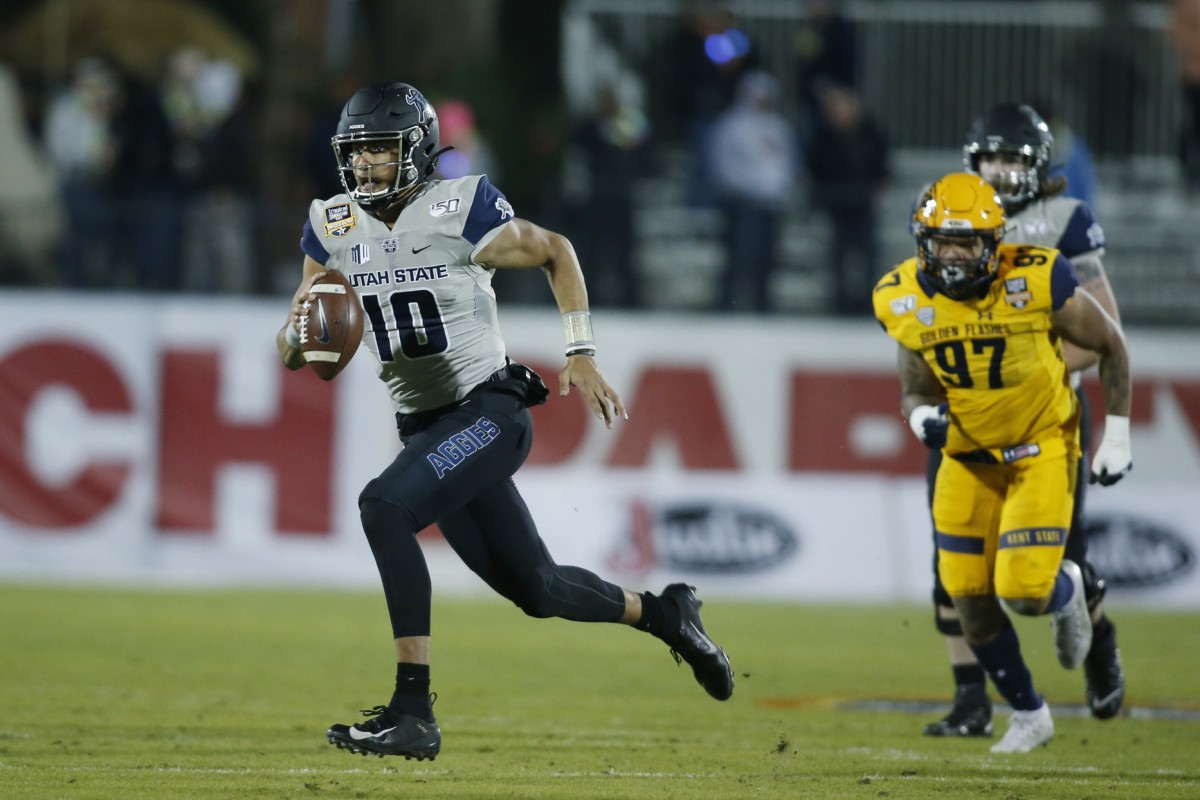
It doesn’t take Bill Walsh to understand Love’s description of the offenses he ran at Utah State. No huddle. Fast paced. Every call signaled from the sideline. And in total, there were, by Love’s estimation, about 15 plays in each of the schemes he piloted, under three coordinators over four seasons as an Aggie.
Essentially, through that time, Love got really good at a few things, then headed into a league that would ask him to adjust to doing a lot more, making his projection tougher for scouts.
And the projection wasn’t just in the tactical part of the game. Love’s greatest strength—as a playmaker—had to be managed, and his fundamentals (in particular, his footwork) needed reworking. That’s why when getting picked the same year as Joe Burrow, Justin Herbert and Tua Tagovailoa, he got the rap for being raw in comparison to his draft classmates.
“When I watched him, you never know what’s being taught, what’s not being taught, and I’m not trying to disparage anybody by any stretch, but, yeah, there were inconsistencies with the footwork,” LaFleur says. “You’d watch one play, and maybe he’d do it one way one time and a different way the next. It’s all the little details that go into that position. That’s why it’s such a hard position to play.”
“All these guys coming out of college for the most part are pretty raw, but he was a really young guy coming out,” GM Brian Gutekunst says. “He definitely needed the time. He needed to develop. Most of them do, which is what we believe in.”
That was part of why the Packers felt like they had the right situation for Love in 2020—he wouldn’t need to play, not with Rodgers around. The fact that the 21-year-old was drafted during the pandemic made the planned apprenticeship only more necessary, with his first spring as a pro and his first set of preseason games wiped out completely.
That meant 2021 would give him his first set of OTAs, his first full-squad minicamp, and his first NFL action, really, for anyone outside of the Packers building to see, in preseason games, and that’d be the foundation he carried into the Chiefs game that November.
That’s why the Packers, at that point, weren’t entirely sure what they had with the player they’d drafted to develop behind Rodgers, the same way they’d drafted Rodgers to develop behind Brett Favre. Love was popular with his teammates. He got along great with Rodgers. He did all the right things. Still, there were plenty of bumps, and it’s not like the way that Sunday in Kansas City went, even if it wasn’t Love’s fault, engendered confidence.
The upshot was that every speed bump wouldn’t be digested as if it were a 12-car pileup, like it might be if everything was out there for public consumption, and his confidence wasn’t going to be shot on the practice field.
“It was really huge to be able to have that time to learn, grow,” Love says. “That rookie year, it’s a lot being thrown on your plate, trying to learn a whole new offense. You haven’t been able to work through these plays and now you’re out in the game. So I think there’s definitely some benefit to [sitting].”
And circumstances around Rodgers would help, too.
Through the springs of 2021 and ’22, with Rodgers staying home in California, Love got to take all the first-team reps in OTAs and got the full attention of a steady stream of well-respected assistants—at first, Nathaniel Hackett and Luke Getsy, and, more recently, Adam Stenavich and Tom Clements—as well as LaFleur.
Then, when Rodgers was around, for the mandatory minicamps, training camps and the regular seasons, he had the benefit of seeing the ground he had to make up, not to mention what was possible within the offense that LaFleur worked with the future Hall of Famer to build.
“It gives you a confidence boost to be able to see somebody do it at such a high level every day and watch some of the craziest throws you’ve ever seen,” Love says. “All types of no-looks, everything, everything you can think of. Just to be able to see him do it and it’s like, O.K., I kind of want to try some of these things. I want to try that. Why can’t I do that, too? Kind of that mindset, being able to see it, be like O.K., that was cool. … It just kind of makes your imagination go.”
At practice, because Rodgers would be locked in when he was on the field, Love was a fly on the wall watching No. 12. When they got to the meeting room, the conversation would flow—and Love tried to be a sponge for information as best he could.
“He would see a play [on tape] and he would just be like, Hey J., this is what I was seeing on this, this is why I did this,” Love says. “Then, if I did something in practice, he’d be like, Hey, maybe think about this next time. He was always helping.”
And last year, Love’s ability to apply what Rodgers was giving him really started to show up.
It was in that Eagles game, but it was also in practice, through a six-week period during which Rodgers wasn’t practicing, as he tried to heal his broken thumb. Love got the first-team reps, and there wasn’t a lot of handholding needed to make sure the team was getting the work done that the other 10 guys in the huddle needed. The situation gave the Packers a window through which they could see their three-year plan coming together in full.
“You just started seeing what he could do there,” Gutekunst says. “He’s getting to that point now where really the next step in his development is he has to play and be ready. That’s kind of what it was.”
Now, we’ll get to see what it will be.
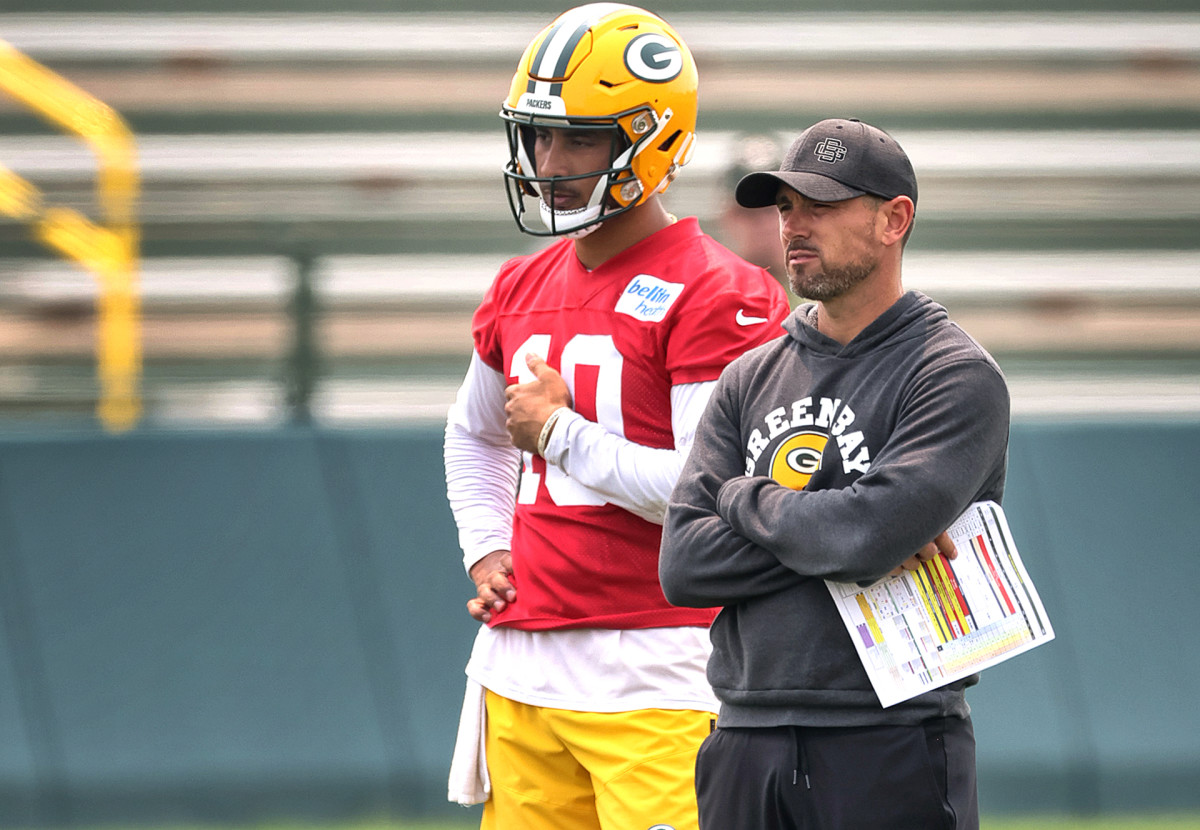
Whether this works, I left Green Bay learning two things: First, the Packers are convinced they did right by Love in bringing him along slowly. And, second, they’re just as sure that this was the right time to turn the page and put him on the field.
“I think—this is my opinion—the league would benefit if more guys took that approach,” LaFleur says. “What happens is, these guys, a lot of them, get thrust into situations where there’s not a lot of talent around them, and they lose confidence. I’ve seen it happen too many times, and it’s hard to recover from that. I do think that we would be able to develop more quarterbacks if guys were given a couple of years to sit and learn the game.”
There are reminders, too, around this place that Rodgers had miles to go when he got into the league. In fact, beyond sitting early on, it wasn’t really until midway through his second season starting that the team really took off. The Packers drafted two quarterbacks, one in the second round (Brian Brohm), one in the seventh (Matt Flynn), the year Rodgers was elevated, and they went to 10–14 over the quarterback’s first season and a half at the helm.
Green Bay followed that with 32 wins in 40 games (they were 36–10, including playoffs) over the next two and a half years, and the rest is history.
Which, of course, is why the bar is so high for Packers quarterbacks. And while LaFleur hasn’t addressed the Favre-Rodgers standard with Love directly (“not specifically, I’ve just told him that, in particular with that position, there’s going to be some highs and there’s going to be some lows”), the quarterback certainly isn’t running from it, choosing instead to embrace the challenge of clearing a bar set so high.
“Oh, yeah, that’s definitely the goal,” Love says. “It’s like you said, they set the bar high. The standards are high, being a quarterback here for the Packers, and that’s one thing that just, being here for three years under Aaron, I was able to see how he does it, how he handles business every day. But I like that pressure; I like to be able to be held to a high standard. That’s what Matt does. Holds me, and all the other quarterbacks, to a really high standard.
“I wouldn’t want it any other way.”
That’s another reason why that Eagles game was such a flash point. It, of course, doesn’t mean Love is going to be even a very good NFL starter, let alone what his predecessors became over the past 30 years. What it does show is he won’t melt under the spotlight.
That his teammates know it will help.
Truth is, veteran left tackle David Bakhtiari remembers very little about how Love played that night in Philly. But that, as he sees it, Love is everything he could’ve hoped for, like how Love has commanded the huddle, handled checks and used his cadence variation in a way that keeps the defense on its toes. It’s, at the very least, to him, a good sign that the train that Rodgers conducted for all those years is still on the tracks.
“You want to have normalcy,” Bakhtiari says. “I’ve had guards drop out, and you bring in another guy, and I’m noticing a lot of Yo, come on. If you have a guy that just steps in and the chemistry is there and we have good fits on our blocks, good communications, he’s seeing the adjustments, that’s exactly what you want from someone stepping in. For him coming in and having a full offseason with him and even getting through this bit of camp to start off, [the normalcy at quarterback] is what I appreciate the most.”
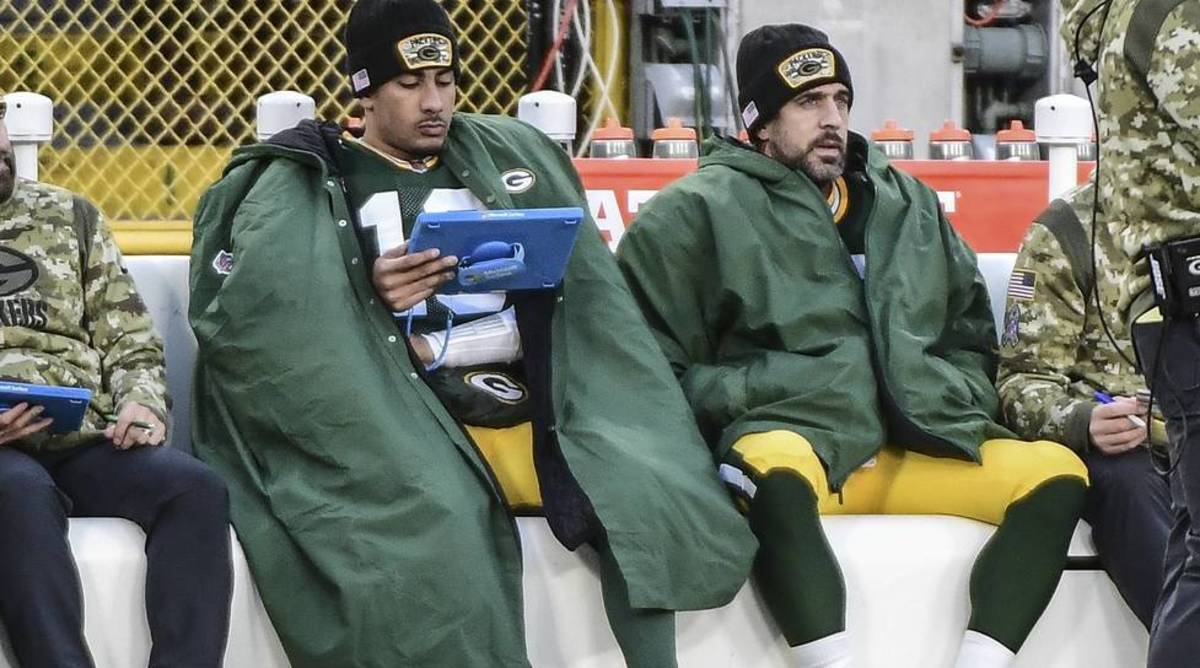
The steadiness fits with a couple of pieces of advice from teammates. One came from veteran corner Jaire Alexander, who told him to “turn all my media off” (Love says he still has the social media apps on his phone, but they’re sitting dormant). The other was the text he got from Rodgers before camp (“what Aaron did was a pretty cool thing,” LaFleur says), imploring Love to be yourself—which Love took as advice to run his own race, rather than one against quarterbacks of Packers past.
All of that plays right into Love’s confident, self-assured tone as he puts together the sum of all these experiences and peers out into the future. He skips no beats on what he expects a curious public to see next month when he’s an NFL starter for the first time.
“A great player, I don’t know how else to put it,” Love says, smiling. “I’m just excited to be out there. [You can] turn my college film on and kind of see the things I did in college. I think a lot of people just haven’t seen me play enough and are not really familiar with my game. But I’m a baller. So that’s what they’ll see.”
LaFleur, for his part, was more measured. The Packers coach serves up the reminder that how Love plays won’t be just about his own progress but also what’s around him. Whether his line can stay healthy. Whether his young receivers come along. Whether Green Bay’s very capable run game can keep its normal pace with Rodgers plucked out of the equation.
All of that will factor into answering the question of what sort of player we’re going to see in a spot that seems to turn over once a generation. And as good as the Packers might feel, there’s only one way to really know.
“I think we’re about to find out,” LaFleur says. “It’s one thing to see it in practice. Practice gives you confidence that he’s going to be able to go out there and do it in a game. Ultimately, you got to go do it in a game. Like I said before, it’s not just Jordan Love. Everybody’s going to judge it, but it’s how do we protect up front? How are we running the football? How fast are these receivers and tight ends? …
“There’s just so many layers. The key for me is going to be, all right, when we have the play call, when we have the look, when the wideout wins his route or tight end wins his route or back wins his route and they’re open, is he able to make that play? The automatic plays? I got confidence that he’s going to be able to do that, but ultimately, you got to go do it.”
On that night in Philly, Love did. And as LaFleur says, confident as Love may be, now, we get to see the rest of the story.
